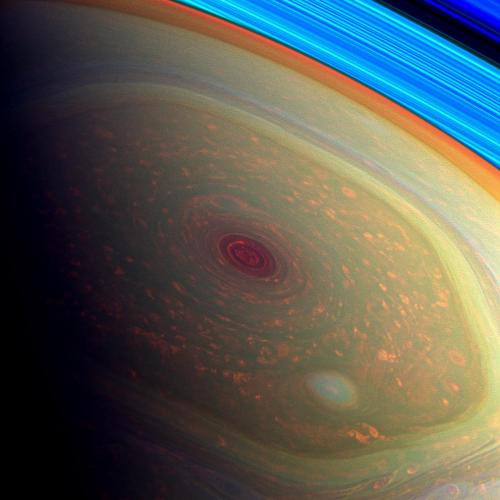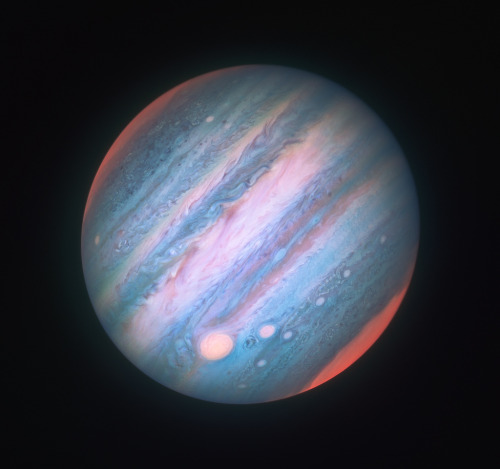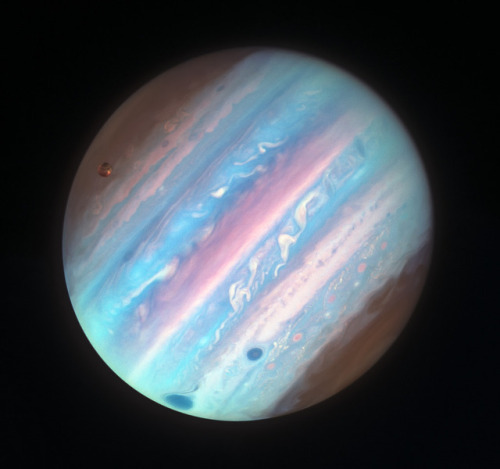The Einstein Cross Gravitational Lens : Most Galaxies Have A Single Nucleus – Does This Galaxy Have

The Einstein Cross Gravitational Lens : Most galaxies have a single nucleus – does this galaxy have four? The strange answer leads astronomers to conclude that the nucleus of the surrounding galaxy is not even visible in this image. The central cloverleaf is rather light emitted from a background quasar. The gravitational field of the visible foreground galaxy breaks light from this distant quasar into four distinct images. The quasar must be properly aligned behind the center of a massive galaxy for a mirage like this to be evident. The general effect is known as gravitational lensing, and this specific case is known as the Einstein Cross. Stranger still, the images of the Einstein Cross vary in relative brightness, enhanced occasionally by the additional gravitational microlensing effect of specific stars in the foreground galaxy. via NASA
More Posts from Night-hides-the-world and Others

Saturns Swirling Cloudscape
js
Everyone (Even You!) Can Use Satellite Data
At NASA we’re pretty great at putting satellites and science instruments into orbit around Earth. But it turns out we’re also pretty great at showing people how to get and use all that data.
One of the top ways you can learn how to use NASA data is our ARSET program. ARSET is our Applied Remote Sensing Training program and it helps people build skills that integrate all these Earth science data into their decision making.

ARSET will train you on how to use data from a variety of Earth-observing satellites and instruments aboard the International Space Station.
Once you take a training, you’ll be in GREAT company because thousands of people have taken an ARSET training.

We hold in person and online trainings to people around the world, showing them how to use NASA Earth science data. Trainings are offered in air quality, climate, disaster, health, land, water resources and wildfire management.
For example, if you’re trying to track how much fresh drinking water there is in your watershed, you can take an ARSET training and learn how to find satellite data on how much precipitation has fallen over a certain time period or even things like the ‘moistness’ of soil and the quality of the water.

Best yet, all NASA Earth observing data is open and freely available to the whole world! That’s likely one of the reasons we’ve had participants from 172 of the approximately 190 countries on Earth.

Since its beginning 10 years ago, ARSET has trained more than 30 thousand people all over the world. They’ve also worked with people from more than 7,500 different organizations and that includes government agencies, non-profit groups, advocacy organizations, private industry.
And even though 2019 is ARSET’s 10th birthday – we’ve only just begun. Every year about 60% of the organizations and agencies we train are new to the program. We’re training just about anyone who is anyone doing Earth science on Earth!
Join us, learn more about how we train people to use Earth observing data here, and heck, you can even take a training yourself: https://arset.gsfc.nasa.gov/.
Make sure to follow us on Tumblr for your regular dose of space: http://nasa.tumblr.com






Time for another out of this world comic for starry cosmos month!
This week’s entry, “Gamma Ray Bursts”
http://imagine.gsfc.nasa.gov/science/objects/bursts1.html
http://earthsky.org/space/gamma-ray-bursts-are-the-most-powerful-explosions-in-the-universe
The #HubbleTelescope captured these auroras on #jupiter caused by light waves interacting with the planet’s magnetic fields.
Video released by SpaceX of a pad abort test.
“The video is filmed from the point-of-view of an astronaut inside the rocket — the rocket that accelerates from zero to 100 mph in 1.2 seconds, that is.” x


Jupiter in Near-Infrared Jupiter and Ganymede in Near-UV and Blue
by Judy Schmidt





Starry Greetings!
Let’s start hot objects month with our infamous red hypergiant: VY CANIS MAJORIS!
https://www.universetoday.com/39472/vy-canis-majoris/
http://astrobob.areavoices.com/2012/01/28/the-biggest-star-in-the-sky-and-how-to-see-it/
https://www.universetoday.com/13507/what-is-the-biggest-star-in-the-universe/
https://www.space.com/31209-hypergiant-star-vy-canis-major-weight-loss.html
-
 siphonophorus reblogged this · 2 years ago
siphonophorus reblogged this · 2 years ago -
 662607015 reblogged this · 2 years ago
662607015 reblogged this · 2 years ago -
 bluegreen1 liked this · 2 years ago
bluegreen1 liked this · 2 years ago -
 potatoplacebitch liked this · 2 years ago
potatoplacebitch liked this · 2 years ago -
 tethys-the-aquatic-sea-godness reblogged this · 2 years ago
tethys-the-aquatic-sea-godness reblogged this · 2 years ago -
 tethys-the-aquatic-sea-godness liked this · 2 years ago
tethys-the-aquatic-sea-godness liked this · 2 years ago -
 662607015 liked this · 2 years ago
662607015 liked this · 2 years ago -
 myalgias reblogged this · 2 years ago
myalgias reblogged this · 2 years ago -
 ramses-the-everlasting liked this · 2 years ago
ramses-the-everlasting liked this · 2 years ago -
 thepalindromist liked this · 2 years ago
thepalindromist liked this · 2 years ago -
 vargwolf liked this · 2 years ago
vargwolf liked this · 2 years ago -
 trinity1967 liked this · 2 years ago
trinity1967 liked this · 2 years ago -
 tangled-grace reblogged this · 2 years ago
tangled-grace reblogged this · 2 years ago -
 ermo-thoughts reblogged this · 2 years ago
ermo-thoughts reblogged this · 2 years ago -
 lostintheunicornland reblogged this · 2 years ago
lostintheunicornland reblogged this · 2 years ago -
 lostintheunicornland liked this · 2 years ago
lostintheunicornland liked this · 2 years ago -
 yikesmyman liked this · 2 years ago
yikesmyman liked this · 2 years ago -
 dplusl2 liked this · 2 years ago
dplusl2 liked this · 2 years ago -
 allbeautydestroyed reblogged this · 2 years ago
allbeautydestroyed reblogged this · 2 years ago -
 maykr reblogged this · 2 years ago
maykr reblogged this · 2 years ago -
 geocaprican reblogged this · 2 years ago
geocaprican reblogged this · 2 years ago -
 minimarimbist98 reblogged this · 2 years ago
minimarimbist98 reblogged this · 2 years ago -
 btwixt-and-between liked this · 2 years ago
btwixt-and-between liked this · 2 years ago -
 geminiyeezus liked this · 2 years ago
geminiyeezus liked this · 2 years ago -
 aealoarcturus reblogged this · 2 years ago
aealoarcturus reblogged this · 2 years ago -
 small-cog reblogged this · 2 years ago
small-cog reblogged this · 2 years ago -
 night-hides-the-world reblogged this · 2 years ago
night-hides-the-world reblogged this · 2 years ago -
 justanothervirus liked this · 2 years ago
justanothervirus liked this · 2 years ago -
 lisahenrietta liked this · 2 years ago
lisahenrietta liked this · 2 years ago -
 tuff-n-jess liked this · 2 years ago
tuff-n-jess liked this · 2 years ago -
 jadegrimm liked this · 2 years ago
jadegrimm liked this · 2 years ago -
 geocaprican liked this · 2 years ago
geocaprican liked this · 2 years ago -
 minimarimbist98 liked this · 2 years ago
minimarimbist98 liked this · 2 years ago -
 lanemanandcoach liked this · 2 years ago
lanemanandcoach liked this · 2 years ago -
 yakutyanochka liked this · 2 years ago
yakutyanochka liked this · 2 years ago -
 detaras liked this · 2 years ago
detaras liked this · 2 years ago -
 mayax81 reblogged this · 2 years ago
mayax81 reblogged this · 2 years ago
Astronomy and the other wonders you witness when you look to the skies.
115 posts


